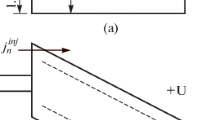Abstract
Several processes based on the free-electron concept are briefly reviewed in this paper. Using a quantum-tunneling model, a simple theory for determining the effective mass of charge carriers in amorphous semiconductors is presented. It is shown that a charge carrier has different effective masses in the extended and tail states, and that the sign of the effective mass changes as the charge carrier crosses its mobility edge. This is used to explain the anomalous Hall coefficient observed in a-Si : H. The theory is used to calculate Tauc's absorption relation, theoretically. It is found that deviations from the Tauc plot observed in some a-solids may be attributed to the photon-energy-dependent matrix element. Some transport properties of charge carriers are also considered.
Similar content being viewed by others
References
N. F. Mott and E. A. Davis, “Electronic Processes in Non-Crystalline Materials” (Clarendon Press, Oxford, 1979).
R. A. Street, “Hydrogenated Amorphous Silicon” (Cambridge University Press, Cambridge, 1991).
K. Morigaki, “Physics of Amorphous Semiconductors” (World Scientific — Imperial College Press, London, 1999).
J. Singh and K. Shimakawa, “Advances in Amorphous Semiconductors” (Taylor & Francis, London and New York, 2003).
K. Shimakawa, A. Kolobov and S. R. Elliott, Adv. Phys. 44 (1995) 475.
S. Kivelson and C. D. Gelatt Jr., Phys. Rev. B 19 (1979) 5160.
J. Singh, “Excitation Energy Transfer Processes in Condensed Matter” (Plenum, N.Y., 1994).
J. Singh, J. Mater. Sci. 14 (2003) 171.
J. Singh, T. Aoki and K. Shimakawa, Philos. Mag. B 82 (2002) 855.
P. G. Lecomber, D. J. Jones and W. E. Spear, Philos. Mag. 35 (1977) 1173.
L. Friedman, J. Non-Cryst. Solids 6 (1971) 329.
D. Emin, Philos. Mag. 35 (1977) 1189, and in “Proceedings of the Seventh International Conference on Amorphous and Liquid Semiconductors”, edited by W. E. Spear (CICL, Edinburgh, 1977) p. 249.
N. F. Mott, Philos. Mag. B 63 (1991) 3.
H. Okamoto, K. Hattori and Y. Hamakawa, J. Non-Cryst. Solids 164–166 (1993) 445.
W. E. Spear, G. Willeke and P. G. Lecomber, Physica B 117–118 (1983) 909.
G. D. Cody, Semicond. Semimet. 21 (1984) 11.
W. E. Spear, in “Amorphous Silicon and Related Materials”, edited by H. Fritzsche (World Scientific, Singapore, 1988) p. 721.
D. Monroe, Phys. Rev. Lett. 54 (1985) 146.
Author information
Authors and Affiliations
Rights and permissions
About this article
Cite this article
Singh, J. Free-electron processes in amorphous semiconductors. Journal of Materials Science: Materials in Electronics 14, 689–692 (2003). https://doi.org/10.1023/A:1026174903429
Issue Date:
DOI: https://doi.org/10.1023/A:1026174903429




